Exam MS-100: Microsoft 365 Identity and Services
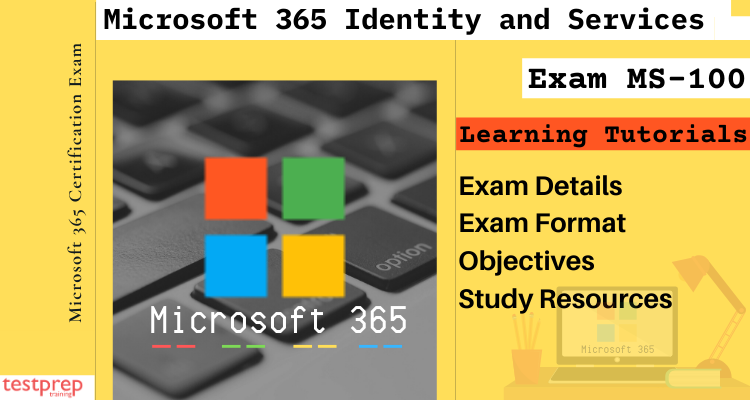
Microsoft 365 Identity and Services (MS-100) exam is for candidates who are Microsoft 365 Enterprise Administrators with abilities to evaluate, plan, migrate, deploy, and manage Microsoft 365 services. They are responsible for performing various Microsoft 365 tenant management tasks for an enterprise, including its identities, security, compliance, and supporting technologies.
Knowledge required for the Exam
- Candidates applying for the exam should have a working knowledge of Microsoft 365 workloads.
- They must have been an administrator for at least one Microsoft 365 workload (Exchange, SharePoint, Skype for Business, or Windows as a Service).
- Moreover, they should also have a working knowledge of networking, server administration, and IT fundamentals such as DNS, Active Directory, and PowerShell.
Skills Gained
Candidates in this exam will be able to:
- Design, configure, and manage Microsoft 365 tenant
- Understand Office 365 product functionality
- Configure Office 365
- Manage Office 365 ProPlus deployments
- Plan and implement identity synchronization
- Implement application and external access
Microsoft 365 Learning Path
Microsoft provides exam learning paths that help the candidates to understand and know about the concepts during the preparation. Moreover, these exam concepts are provided with sections and subsections to make you learn about it in depth. Microsoft provides candidates access to the learning path that helps them to understand the concepts in a step by step format. This includes:
- Designing and implementing Microsoft 365 services
- Managing user identity and roles
- Managing access and authentication
- Planning Office 365 workloads and applications
Microsoft MS-100 Certification Path
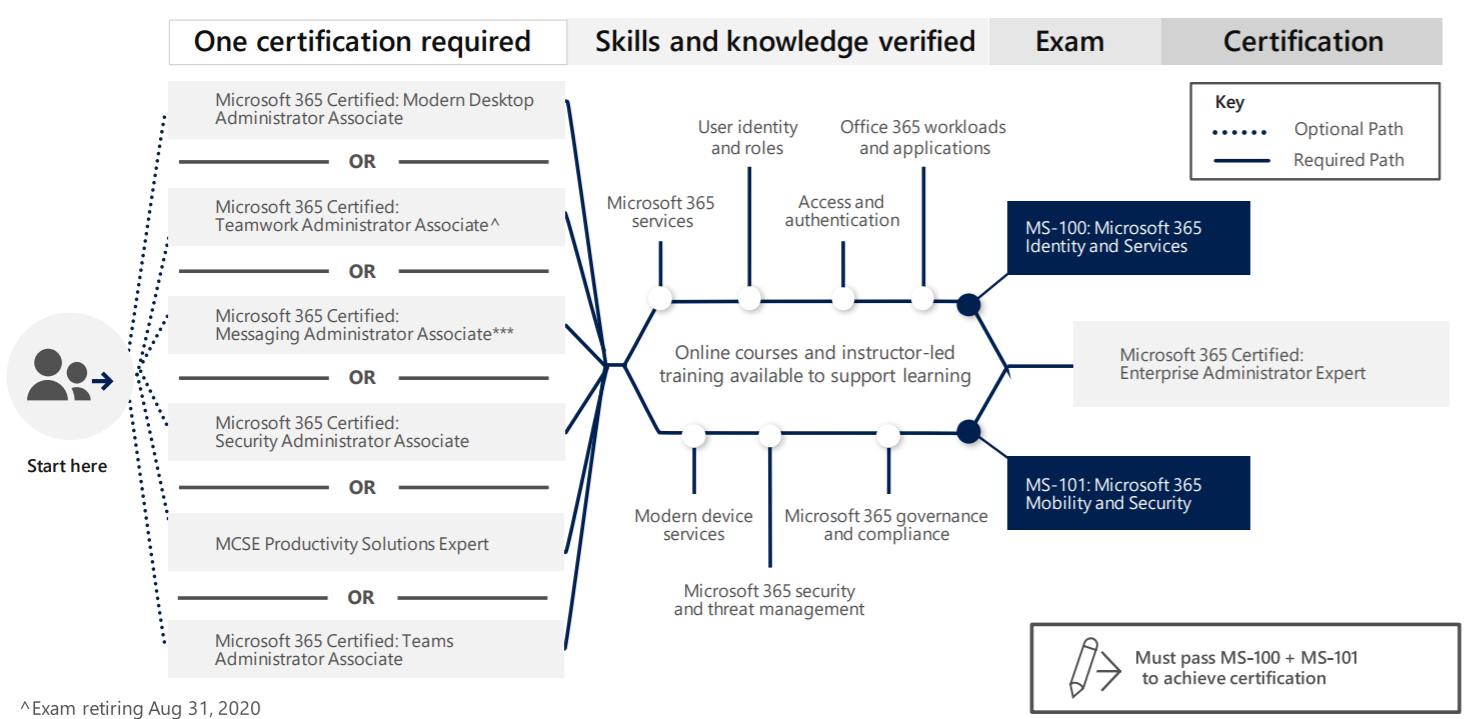
MS-100: Microsoft 365 Identity and Services Interview Questions
Now, let us look at some MS-100: Microsoft 365 Identity and Services Interview Questions.
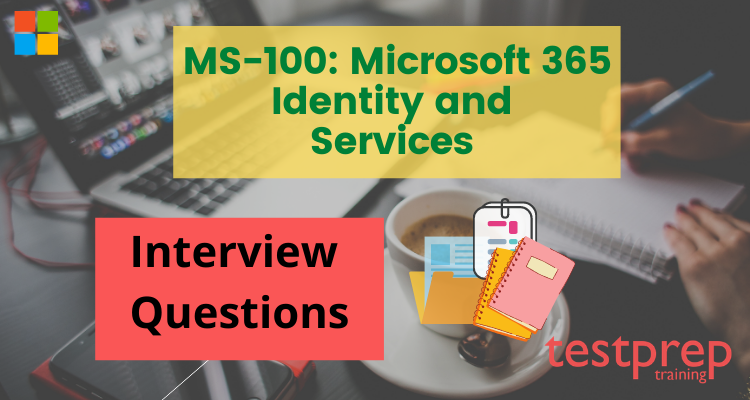
Exam Format
Microsoft MS-100 exam questions will range between 40-60 questions. To complete the exam, candidates will get 180 minutes. The types of questions that candidates can face in the exam include scenario-based single answer questions, multiple-choice questions, arrange in the correct sequence type questions, drag & drop questions, mark review, drag, and drop, etc. However, to pass the exam, a candidate has to score a minimum of 700 or more. To apply for the exam, the examination fee is $165 USD including taxes. And, candidates can give the exam in English and the Japanese language.
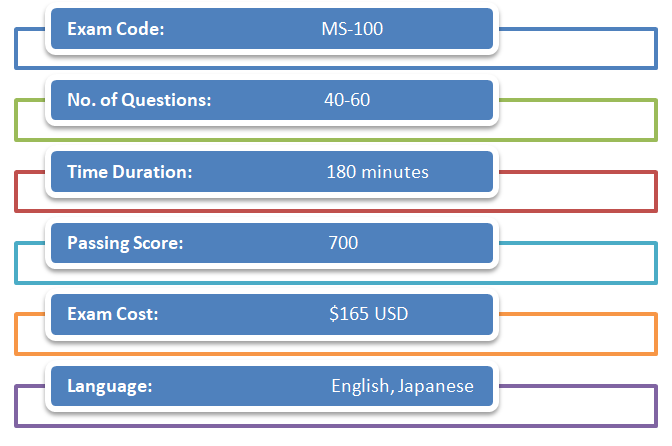
Exam Scheduling
Microsoft MS-100 exam measures the ability to perform technical tasks for designing and implementing Microsoft 365 services with managing access and authentication. Candidates also plan Office workloads and applications. However, candidates can schedule their exam with the 
Microsoft 365 MS-100 Exam Course Outline
The course Outline for the Microsoft MS-100 exam was updated on February 3, 2023
1. Deploy and manage a Microsoft 365 tenant (15—20%)
Plan and implement a Microsoft 365 tenant
- plan a tenant (Microsoft Documentation: Plan your tenant in Microsoft 365)
- create a tenant (Microsoft Documentation: Set up your Microsoft 365 tenant)
- implement and manage domains (Microsoft Documentation: Add a domain to Microsoft 365)
- configure organizational settings, including security, privacy, and profile (Microsoft Documentation: Use policy settings to manage privacy controls)
Monitor Microsoft 365 tenant health
- create and manage service requests (Microsoft Documentation: Manage service requests in Service Manager)
- create an incident response plan (Microsoft Documentation: Incident response planning)
- monitor service health check (Microsoft Documentation: Microsoft 365 service health)
- monitor application access (Microsoft Documentation: Microsoft 365 Apps monitoring)
- configure and review reports, including Azure Monitor logs and Log Analytics workspaces (Microsoft Documentation: Create a Log Analytics workspace)
- schedule and review usage metrics, including Microsoft Viva Insights and Adoption Score
2. Plan and manage user identity and roles (30—35%)
Plan identity synchronization
- design synchronization solutions for multitenant and multi-forest scenarios (Microsoft Documentation: Topologies for Azure AD Connect)
- evaluate whether objects should be synchronized, not synchronized, or created as cloud-only (Microsoft Documentation: One or more objects don’t sync, End-to-end troubleshooting of Azure AD)
- identify which Azure AD Connect features to enable, such as writeback and device synchronization (Microsoft Documentation: Custom installation of Azure Active Directory Connect)
- identify synchronization pre-requisites, including connectivity method, permissions, and server requirements (Microsoft Documentation: Set up directory synchronization for Microsoft 365)
- choose between Azure AD Connect and Azure AD Connect cloud sync
- plan user sign-in for Azure AD hybrid identities, including pass-through authentication, seamless, and SSO (Microsoft Documentation: Choose the right authentication method, Azure Active Directory Seamless Single Sign-On)
Implement and manage identity synchronization with Azure AD
- prepare for identity synchronization by using IdFix (Microsoft Documentation: Prepare for identity synchronization to Microsoft 365)
- configure and manage directory synchronization by using Azure AD Connect cloud sync (Microsoft Documentation: Create a new configuration for Azure AD)
- configure and manage directory synchronization by using Azure AD Connect
- configure Azure AD Connect object filters (Microsoft Documentation: Azure AD Connect sync: Configure filtering)
- monitor synchronization by using Azure AD Connect Health (Microsoft Documentation: Azure AD Connect)
- troubleshoot Azure AD Connect synchronization (Microsoft Documentation: Understanding errors during Azure AD synchronization)
Plan and manage Azure AD identities
- plan Azure AD identities (Microsoft Documentation: Determine your cloud identity model)
- create and manage users (Microsoft Documentation: Microsoft 365 user accounts)
- create and manage guest users (Microsoft Documentation: Manage groups guest access)
- create and manage groups, including Microsoft 365 groups (Microsoft Documentation: Manage who can create Microsoft 365 Groups)
- manage and monitor Microsoft 365 license allocations (Microsoft Documentation: View Microsoft 365 licenses and services with PowerShell)
- perform bulk user management, including PowerShell (Microsoft Documentation: Create Microsoft 365 user accounts with PowerShell)
Plan and manage roles in Microsoft 365
- plan for role assignments (Microsoft Documentation: Roles for Microsoft 365 services in Azure Active Directory)
- manage roles in Microsoft 365 admin center (Microsoft Documentation: admin roles in the Microsoft 365 admin center)
- manage administrative units (Microsoft Documentation: Administrative units in Azure Active Directory)
- plan and implement privileged identity management for Azure AD roles (Microsoft Documentation: Azure AD Privileged Identity Management)
3. Manage access and authentication (20—25%)
Plan and implement authentication
- choose an authentication method, including Windows Hello for Business, passwordless, and tokens (Microsoft Documentation: Passwordless authentication options for Azure Active Directory)
- implement and manage authentication methods (Microsoft Documentation: authentication and verification methods)
- implement and manage self-service password reset (SSPR) (Microsoft Documentation: Azure AD SSPR)
- implement and manage Azure AD password protection (Microsoft Documentation: Azure AD Password Protection for Active Directory Domain Services)
- configure and manage multi-factor authentication (MFA) (Microsoft Documentation: Set up multifactor authentication for Microsoft 365)
- investigate and resolve authentication issues (Microsoft Documentation: Troubleshoot Azure Multi-Factor Authentication issues)
Plan and implement secure access
- plan and implement access reviews in Azure AD identity governance (Microsoft Documentation: Azure AD access reviews)
- plan and implement entitlement packages in Azure AD identity governance (Microsoft Documentation: Azure AD entitlement management)
- plan for identity protection (Microsoft Documentation: Identity Protection)
- implement and manage Azure AD Identity Protection (Microsoft Documentation: Manage Azure AD Identity Protection)
- plan conditional access policies (Microsoft Documentation: Conditional Access)
- implement and manage conditional access policies
Plan and implement application access
- plan access and authentication to application registrations and Azure AD enterprise applications (Microsoft Documentation: applications application management in Azure Active Directory)
- configure application registration in Azure AD (Microsoft Documentation: Register an app with Azure Active Directory)
- manage user permissions for application registrations (Microsoft Documentation: Azure AD built-in roles)
- manage OAuth application requests in Azure AD, Microsoft Defender for Cloud Apps, and Microsoft 365 Defender (Microsoft Documentation: OAuth app policies)
- configure Azure AD Application Proxy (Microsoft Documentation: Using Azure AD Application Proxy)
- publish enterprise applications in Azure AD (Microsoft Documentation: Submit a request to publish your application)
4. Plan Microsoft 365 workloads and applications (20—25%)
Plan and implement Microsoft 365 Apps deployment
- plan for client connectivity to Microsoft 365 workloads (Microsoft Documentation: Microsoft 365 network connectivity principles)
- plan Microsoft 365 App compatibility by using the Readiness Toolkit (Microsoft Documentation: Use the Readiness Toolkit to assess application compatibility)
- plan for Microsoft 365 Apps updates (Microsoft Documentation: Overview of the update process for Microsoft 365 Apps)
- specify initial configuration for Microsoft 365 Apps by using the Microsoft 365 Apps admin center (Microsoft Documentation: Set up Microsoft 365 Apps for business)
- implement Microsoft 365 Apps deployment and software downloads (Microsoft Documentation: Overview of the Microsoft 365 Apps admin center)
Plan and implement Exchange Online deployments
- plan for DNS records required by Exchange Online (Microsoft Documentation: External Domain Name System records for Office 365)
- plan and implement an Exchange hybrid organization (Microsoft Documentation: Exchange Server hybrid deployments)
- plan and implement mail routing, including connectors, mail flow rules, and remote domains (Microsoft Documentation: Set up connectors to route mail between Microsoft 365)
- plan and implement organizational settings (Microsoft Documentation: Plan and manage organizational settings with Exchange Online)
Plan and implement Microsoft SharePoint Online, OneDrive, and Microsoft Teams
- specify SharePoint site types, site collections, and lists (Microsoft Documentation: Overview of sites and site collections in SharePoint Server)
- plan a migration strategy for SharePoint Online and OneDrive (Microsoft Documentation: Overview of the SharePoint Migration Tool (SPMT))
- identify hybrid requirements for SharePoint Online (Microsoft Documentation: Hardware and software requirements for SharePoint hybrid)
- manage access configurations for SharePoint Online and Microsoft Teams (Microsoft Documentation: Manage sharing settings)
- manage SharePoint Online tenant and site settings (Microsoft Documentation: SharePoint Online tenant properties)
- map Phone System features to requirements (Microsoft Documentation: Microsoft 365 and Office 365 platform service description)
- plan and implement organizational settings (Microsoft Documentation: Plan and manage organizational settings with Exchange Online)
- plan, implement, and manage guest and external access (Microsoft Documentation: Guest users in Microsoft 365 admin center)
Exam Policies
Microsoft provides exam policies to help the candidates to plan and manage a positive outcome. Microsoft Certification exam policies give candidates access to all the exam-related details, accompanying the before and after exam procedures. These exam policies are the inclusion of certain rules that need to be followed during the exam time or at testing centers. On this page, the candidates will get information about after the exam or before exam procedures. This includes the exam retaking process, rules to be followed during the exam time, and other information about the exams and its testing centers.
For more Visit: Microsoft 365 Identity and Services (MS-100) Exam FAQs
Preparation Guide for Microsoft Identity and Services (MS-100) Exam
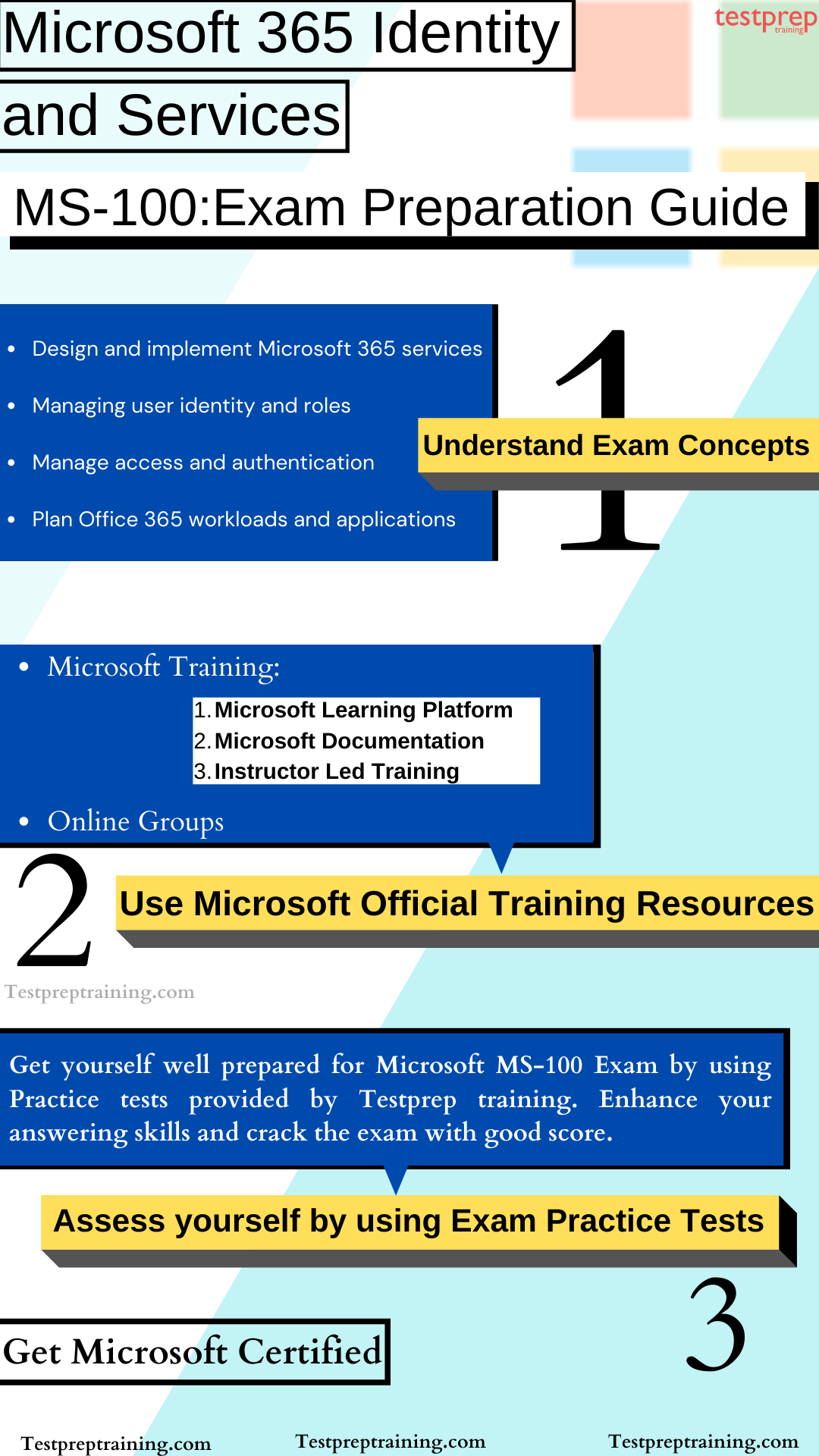
Microsoft Learning Platform
The learning resource that will be beneficial during the exam preparation is the Microsoft learning platform. However, make sure to go through the official website of Microsoft. For the MS-100 exam, it would be best to first go through the Microsoft official website to get authentic information about the exam. You can easily locate the MS-100 page where you can just go through all the necessary information about the MS-100 exam.
Microsoft Docs
After that, you can move on to Microsoft documentation where you can easily understand the concepts. Moreover, you also get to know the different scales of different Microsoft services. Microsoft Docs consists of modules that will help you gain a lot of knowledge about Microsoft 365 and its services. The modules include:
- Designing and configuring Microsoft 365 Tenant
- Managing Microsoft 365 Tenant
- Office 365 Overview
- Configuring Microsoft 365 Clients
- Capturing User-Driven Data
- Planning and Implementing Identity Synchronization
- Implementing Application and External Access
Instructor-led Training
Microsoft provides Instructor-led training that covers central elements of Microsoft 365 enterprise administration – Microsoft 365 tenant and service management, Office management, and Microsoft 365 identity management. Candidates in this will examine all the key components that must be planned for when designing your Microsoft 365 tenant. They will learn to manage tenants that include the configuration of tenant roles and managing your tenant health and services. However, this training course is designed for candidates who are aspiring to the Microsoft Enterprise Admin role. And, they must have completed one of the Microsoft 365 role-based administrator certification paths.
Reference Books
Those who are dedicated to passing the exam know the importance of books during the time of preparation. However, while studying for the exam books can be really helpful to understand the core of the topics. Candidates can take the books available in the market that will help in studying for the MS-100 exam.
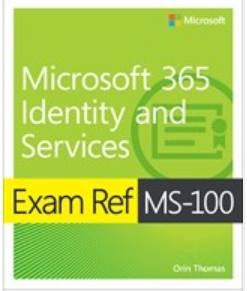 : Microsoft Exam MS-100 Study guide will help candidates to demonstrate the skills and knowledge needed to effectively design, deploy, manage, and secure Microsoft 365 services.
: Microsoft Exam MS-100 Study guide will help candidates to demonstrate the skills and knowledge needed to effectively design, deploy, manage, and secure Microsoft 365 services.
Online Study Groups
One thing that will be beneficial during the exam preparation time is to join study groups. As these groups will help you to stay connected with the other people who are on the same pathway as yours. Moreover, here you can start any discussion about the issue related to the exam or any query. By doing so, you will get the best possible answer to your query.
Practice Tests
This can be a very essential part that can help you to prepare better for the exam. That is to say, practice tests are important as by assessing yourself with these tests you will know about your weak and strong areas. However, by practicing you will be able to improve your answering skills that will result in saving a lot of time. Moreover, the best way to start doing practice tests is after completing one full topic as this will work as a revision part for you. So, make sure to find the best Microsoft MS-100 exam questions for practice.
Prepare and pass the Microsoft Identity and Services (MS-100) Exam.


